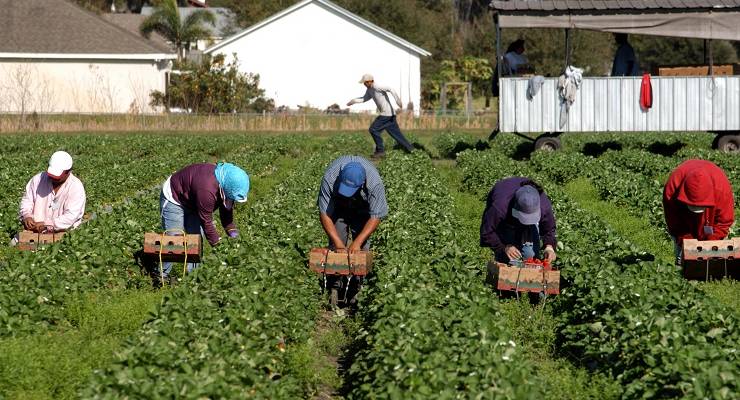
There’s enormous institutional support for high immigration in Australia. Employers have spent much of the past year complaining about their inability to bring in foreign workers and the unwillingness of Australians to work at award wages, with considerable support from economic commentators and major institutions.
The Morrison government, and like-minded governments like Dominic Perrottet’s in New South Wales, are keen to reopen borders to foreign workers as quickly as possible.
To placate the National Party and the influential horticulture industry — Australia’s most exploitative industry after sex work — the Morrison government has even established a visa category designed for the entry of low-paid, unskilled workers from ASEAN countries. The message that Australia regards ASEAN as simply a pool of cheap manual labourers is doubtless burnishing our image in those countries even as we speak.
But in July, Reserve Bank governor Philip Lowe — once an advocate for migration’s impact on labour — upset both the neoliberal right and the cultural left by arguing that migration had played a role in wage stagnation.
That infuriated the right not merely because open borders and flooding markets with labour is central to the neoliberal model but because Lowe might be proved to be correct given Australia’s labour market recovered with spectacular speed from last year’s lockdowns in the absence of hundreds of thousands of migrant workers.
So far, however, jobs growth hasn’t been enough to push wages growth up in the face of employer hostility to changing what is now a decade of enforced wage stagnation.
Economic orthodoxy is that migration is good for employment, although evidence is hard to find. The Productivity Commission found in 2016 that “at an aggregate level, recent immigrants had a negligible impact on wages, employment and participation of the existing labour force”. A more recent academic paper found that “the outcomes local workers has not been adversely affected by recent migrants … Recent migrants have a negative but statistically not significant effect on the unemployment rate of local workers. We find a positive relationship between the labour force participation rate of local workers and the proportion of migrants. We also find that wages are positively correlated with proportion of migrants.”
What is less explored is the impact of temporary migration on wages, and in particular a large pool of foreign students. From about 250,000 student visa grants a year under Labor, more than 400,000 were granted in 2019. That year there were more than 600,000 foreign students in Australia.
Another increasing source of labour is asylum seekers who have arrived by plane and lodged protection applications. Under Peter Dutton, the government lost control of borders and failed to stop a huge rise in people gaming the onshore protection visa system to obtain bridging visas here in order to work, often for labour hire companies that had enabled their travel to Australia. This peaked in 2017 when nearly 28,000 people arrived to claim onshore protection visas; the number was still above 20,000 last year. Now there are more than 90,000 onshore protection claimants either awaiting decision or yet to be deported — up from 80,000 in 2019.
Foreign students and bridging visa holders often work in the sectors best known for exploitation or poor wages growth: retail and hospitality, construction and agriculture. The horticulture industry continues to be synonymous with the exploitation, harassment and abuse of temporary workers, including backpackers and temporary workers from Pacific countries.
None of the studies suggesting that Australian workers benefit from immigration have grappled with the impacts on specific industries, or on the wider labour market, of having three-quarters of a million students, asylum applicants and temporary workers, often with poor language skills and no connections to institutional support, working for Australia’s most exploitive employers.
Two of these rapacious industries — hospitality and horticulture — have been among the loudest voices demanding that the government reopen borders as quickly as possible to allow them greater access to easily exploited workers.
Interestingly, however, some industries are beginning to acknowledge that simply reopening the borders isn’t the answer. Today’s report from Infrastructure Australia on the infrastructure workforce — which has been used by some industry advocates to make ritual demands for more migration — specifically concludes that the industry (which IA points out has relied heavily on foreign students) cannot rely on more migration to address looming workforce shortages, and governments and industry must focus more on training and skills (another ritual of public debate, admittedly).
More to the point, employer group Australian Constructors Association told IA: “With governments around the world investing heavily in infrastructure, even when international borders open, skilled migration is not a viable solution to addressing Australia’s capability and capacity constraints. Instead, Australia needs to find ways to become more productive with our available resources.”
For employers, that’s code for attacking unions like the CFMMEU.
But not being able to rely on importing cheap labour indicates that at least some industries are ahead of the government and the business consensus that no problem can’t be solved with more migrants.
Tomorrow: Boris Johnson, inflation and attacking the neoliberal consensus.








Crikey is committed to hosting lively discussions. Help us keep the conversation useful, interesting and welcoming. We aim to publish comments quickly in the interest of promoting robust conversation, but we’re a small team and we deploy filters to protect against legal risk. Occasionally your comment may be held up while we review, but we’re working as fast as we can to keep the conversation rolling.
The Crikey comment section is members-only content. Please subscribe to leave a comment.
The Crikey comment section is members-only content. Please login to leave a comment.